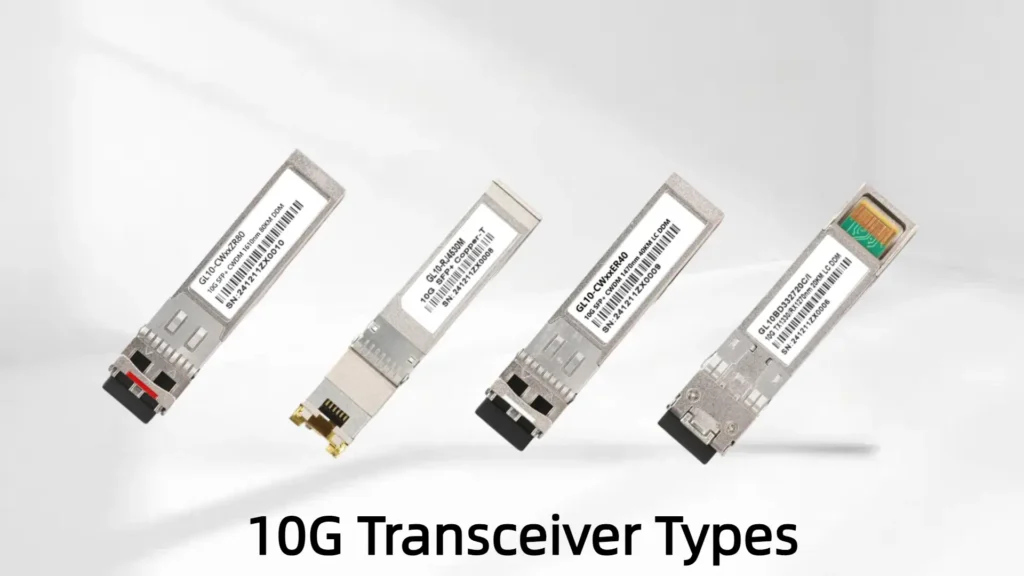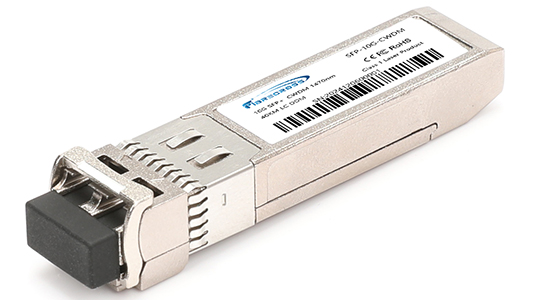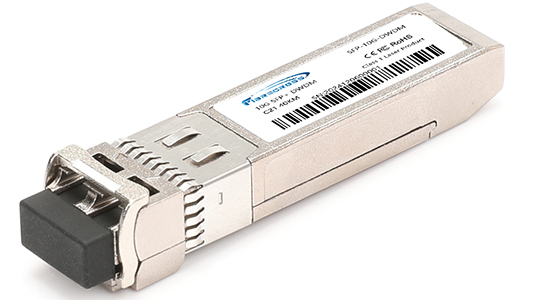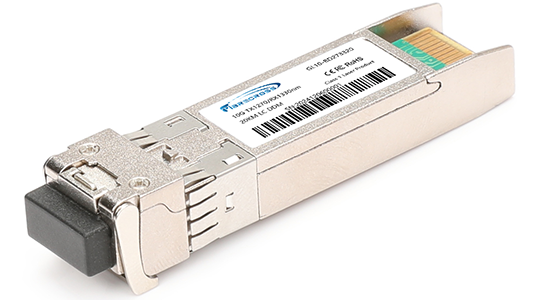10G Transceivers: Types, Distances & Buying Guide
10G connectivity remains a backbone technology for data centers, enterprise aggregation, SANs, and high-performance computing. Choosing the right 10G module affects reach, cost, power, and compatibility. This guide summarizes the common 10G transceiver types, clarifies practical distance and cabling expectations, and gives actionable buying and deployment tips you can use today.
What is a 10G transceiver?
A 10G transceiver is a small pluggable module (commonly SFP+) or an integrated cable assembly that converts electrical signals on a switch/server port to optical or copper signals on the network medium. When used with fiber it’s a fiber optic transceiver; when used with copper it may be a direct-attach cable (DAC) or a 10GBASE-T module.
Common physical forms:
SFP+ (most common for 10G) — pluggable module in 1× SFP+ cage.
XFP — older, larger form factor (less common today).
Direct Attach Copper (DAC) — fixed twinax cable with SFP+ ends (passive or active).
10GBASE-T SFP+ (RJ45) — SFP+ module exposing an RJ45 port for Cat6A/Cat7.

Main types of 10G fiber transceivers (and real distances)
10G SFP+ SR optic transceiver (Short Range)
Use: Short-reach multimode fiber inside racks and across adjacent racks.
Wavelength: 850 nm multimode.
Typical distances: OM1/OM2: short (up to ~33–82 m depending on spec); OM3: up to 300 m; OM4: up to 400 m (real-world depends on channel budget & connectors).
When to pick SR: Top-of-rack to ToR or ToR-to-aggregation within the same hall when cost and low latency matter.
10G SFP+ LR optic transceiver (Long Range)
Use: Single-mode fiber between equipment rooms and across campus links.
Wavelength: 1310 nm single-mode.
Typical distance: 10 km.
When to pick LR: When you need predictable, economical single-mode reach over campus or between data halls.
10G SFP+ ER optic transceiver (Extended Range)
Use: Longer single-mode runs where LR is insufficient.
Wavelength: 1550 nm single-mode.
Typical distance: ~40 km.
When to pick ER: Metropolitan fiber links or cross-campus backbones without amplification.
10G SFP+ ZR optic transceiver (ZeRo/Extended Extended Range)
Use: Long haul single-mode links.
Wavelength: 1550 nm with higher power / more sensitive receivers.
Typical distance: ~80 km or more (varies by optic class and fiber quality — some vendor ZR parts push >100 km with amplification).
When to pick ZR: Carrier or long-haul links where amplification/dispersion management is available or unnecessary.
Note: SR/LR/ER/ZR naming aligns with IEEE and common vendor conventions (10GBASE-SR, -LR, -ER, -ZR). Real reach depends on fiber type, splices, patch panels, and link loss — always calculate link budget.

Copper-based 10G options
10G SFP+ Copper optic transceiver (DAC & 10GBASE-T)
The term “10G SFP+ Copper optic transceiver” often refers to two different copper solutions:
SFP+ Direct Attach Copper (DAC) twinax
Form: SFP+ plug on both ends built into the cable.
Types: Passive DAC (short, low cost) and Active DAC (electronics in cable for longer reach).
Typical lengths: Passive up to 5–7 m (commonly 1–3 m); active up to 10–30 m depending on design.
Use: Server-to-switch or switch-to-switch within same rack/rack row. Lowest latency and cost.
10GBASE-T SFP+ (RJ45)
Form: SFP+ optical module with RJ45 interface for Category cabling.
Typical distance: 100 m over Cat6A/Cat7 for 10GBASE-T. Cat6 may be limited to ~55 m depending on alien crosstalk.
Power: Higher power consumption and latency compared to DAC/SFP+ optics.
Use: When copper structured cabling exists and flexibility with RJ45 patching is preferred.
Other special 10G variants worth knowing
BiDi (Bidirectional) SFP+ 10G: Uses a single fiber pair with wavelength-division on Tx/Rx — saves fiber in constrained ducts; requires matched transceivers (A/B).
CWDM/DWDM SFP+ transceivers (10G): For dense wavelength multiplexing on long single-mode links (metro, carrier). These are used where many wavelengths share a fiber.
- Tunable SFP+ / tunable DWDM: Flexible channel selection for optical networks (carrier-grade).

Practical selection checklist (how to choose)
Distance & fiber type: Multimode? Single-mode? If multimode and <300 m → SR; if single-mode and ≤10 km → LR; if longer → ER/ZR or DWDM.
Form factor & port: Your switch/server must support the optics (SFP+ cage, QSFP breakout, or 10GBASE-T slot). Check hardware compatibility.
Link medium: Do you have existing copper cabling (Cat6A) or fiber plant? Choose 10GBASE-T or optics/DAC accordingly.
Budget vs power: DAC is cheapest and lowest latency for short runs. 10GBASE-T consumes more power. Long-reach optics cost more.
Compatibility / vendor lock: Some vendors enforce vendor-ID checks. Buy MSA-compliant optics and confirm compatibility or choose vendor-validated third-party modules with compatibility guarantee.
DOM/DDM: Digital Optical Monitoring (monitor Tx/Rx power, temperature) — essential for troubleshooting.
Environment & temperature: Industrial temp range modules are available for harsh environments.
Distance margin & future growth: Allow slack for repairs, patch panels, and future re-routing.
Installation & testing tips (grounded, practical)
Fiber cleaning: Always clean connectors before mating — contamination causes most optical faults.
Test end-to-end: Use an optical power meter and light source or an OTDR for longer or complicated links. Verify SFP+ DOM readings match expectations.
Patch-panel loss counts: Count connectors, pigtails, and splices; each adds dB impairments — ensure your link budget covers them.
Use vendor compatibility lists or run a single module test before bulk purchase.
Label both ends of fiber and copper runs to make future moves and troubleshooting faster.

10G Transceiver Types Simple comparison
| Type | Medium | Typical Wavelength | Typical Reach (practical) | Best for |
|---|---|---|---|---|
| 10G SFP+ SR optic transceiver | Multimode fiber | 850 nm | up to 300–400 m (OM3/OM4) | Intra-rack / data hall |
| 10G SFP+ LR optic transceiver | Single-mode fiber | 1310 nm | up to 10 km | Campus links |
| 10G SFP+ ER optic transceiver | Single-mode fiber | 1550 nm | ~40 km | Metro links |
| 10G SFP+ ZR optic transceiver | Single-mode fiber | 1550 nm | ~80 km+ | Long-haul/carrier |
| 10G SFP+ Copper (DAC) | Twinax copper | N/A | 1–30 m | Server-to-switch |
| 10G SFP+ Copper (10GBASE-T) | Cat6A/Cat7 | N/A | up to 100 m | Structured cabling retrofit |
FAQ About 10G Optical Transceiver
SR is for short-reach multimode fiber (850 nm) typically used within data centers (hundreds of meters). LR is single-mode at 1310 nm designed for up to 10 km links.
DAC is ideal for short, low-latency connections inside racks or rack rows. For longer distances (beyond a few meters to tens of meters) or where fiber infrastructure exists, optics or 10GBASE-T are better.
Not always. Many switches accept MSA-compliant modules, but some vendors check vendor IDs. Verify compatibility or get vendor-validated third-party modules.
This term can mean either an SFP+ DAC twinax cable (direct attach copper) or an SFP+ module exposing an RJ45 (10GBASE-T). Choose based on cable plant and distance needs.
Final practical buying checklist (quick)
Confirm port type on your switch (SFP+ vs 10GBASE-T).
Confirm fiber type (OM3/OM4 vs single-mode) and planned distance.
Decide copper vs fiber (cost, power, latency).
Require DOM/DDM if you need monitoring.
Check vendor compatibility and warranty.
Buy one sample and test before large orders.
Conclusion
A good 10G deployment balances distance, cost, power, and compatibility. For short, low-latency rack links, 10G SFP+ Copper (DAC) is the pragmatic choice; for intra-datacenter fiber runs choose 10G SFP+ SR; for campus and metro, choose LR/ER/ZR according to reach. Keep the link budget, fiber type, and hardware compatibility front and center when you buy.




